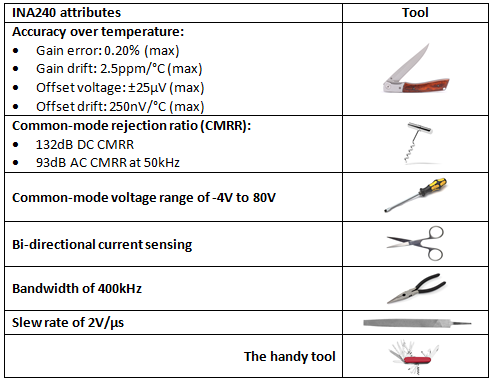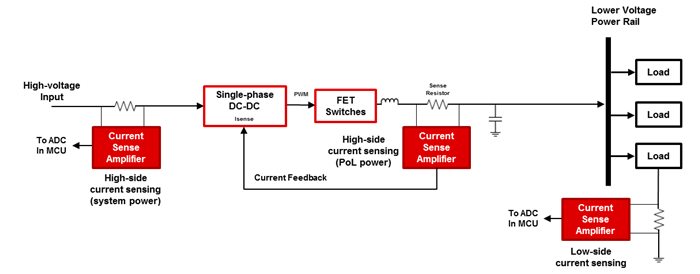SSZTA97 april 2017 INA240
Versatility is a good thing. You probably have one of those tools in your toolbox – probably not advertised as such, but something that just ended up being good for everything from prying and bending, to loosening stuff. You reach for that tool repeatedly because you’re comfortable with it and you know that it’s going to do the job.
Design engineers are no different when designing circuits. They all have their favorite operational amplifier (op amp), low-dropout regulator (LDO), buffer, etc., that they go to time and time again. In this post, I’d like to propose a new versatile tool that is a high-accuracy, high-voltage, high-bandwidth current-sense amplifier with enhanced pulse-width modulation (PWM) rejection for measuring currents across several different circuit placements.
When choosing which tool to grab from your toolbox, you need to know its features before you decide that it’s your go-to solution. Figure 1 summarizes the most important aspects of the INA240 that make it versatile, while analogously showing that every aspect of the device has usefulness for a specific task.
 Figure 1 The Versatile INA240
Figure 1 The Versatile INA240Figure 2 is a block diagram of a generic DC/DC power supply depicting various locations where current sensing is typically performed. Of course, not all current-sensing locations may be used all at once. The first case I show is on the high side at the input. The high common-mode range here is vital, especially if 48V is used as the input voltage. The 80V specification of the INA240 is more than sufficient, even if transients are present on the power rail.
With a ±25μV offset and 0.20% gain error, the measurements will be the most accurate for this class of current-sense amplifier. Additionally, the drift specifications enable ultra-stable current measurements over temperature.
 Figure 2 Generic DC/DC Power-supply
Block Diagram
Figure 2 Generic DC/DC Power-supply
Block DiagramAnother implementation used by many designers (also shown in Figure 2) is just after the inductor storage element. At this location, common-mode voltage and bandwidth are important. The INA240 has a bandwidth of 400kHz, which is sufficient for many designs. Couple this with great CMRR performance (both AC and DC), and the accuracy level is quite high for a high-voltage current-sense amplifier.
A discrete implementation using op amps and external gain resistors may not be possible since the op amp’s common-mode range is typically tied to its supply voltage, so low-side current sensing where the common-mode voltage is ~0V is its limited use case. That’s the beauty of a current-sense amplifier: the common mode is independent of the power-supply voltage. It’s like getting a bonus tool beyond what’s listed in Figure 2.
Current-sense amplifiers are also used on the low side of the load – shown on the far right of Figure 2. A very important feature that impacts this implementation is offset voltage. The sense-resistor value needs to be as small as possible to ensure minimal power dissipation through the resistor, but it is even more necessary in low-side current sensing to ensure that the ground voltage experienced at the load is as close to “real” ground as possible. A low-input offset voltage enables the use of a small resistor. A smaller sense resistor, in turn, allows for a more efficient power-supply design.
There are various other locations in power-supply designs that make full use of all of the INA240’s capabilities. One worth mentioning is functionality in an AC/DC or DC/DC design that enables bi-directional current measurement during battery charging or discharging.
The INA240 tool enables design engineers to measure current accurately and in multiple locations, providing for more efficient power-supply designs. Furthermore, having a single device to purchase makes it a lot easier for the procurement team.
Additional Resources
- Order the INA240 evaluation module (EVM).
- Check out these TI TechNotes:
- Check out these reference designs from the TI Designs library: